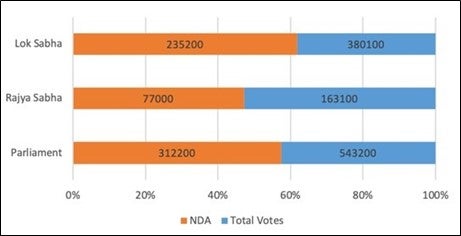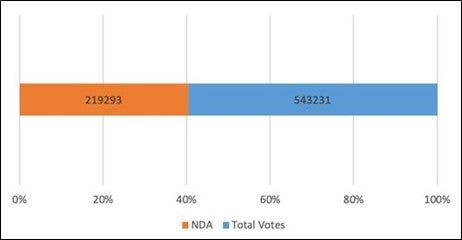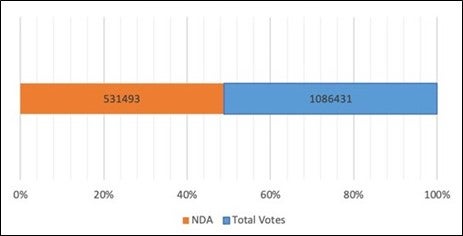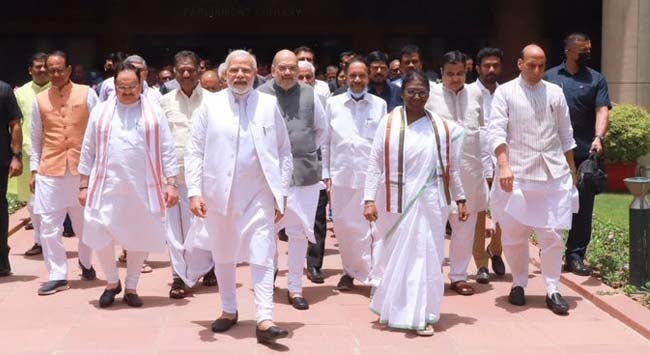Summary
The election for India’s next president will be held on 18 July 2022. The candidate from the ruling Bharatiya Janata Party-led National Democratic Alliance, Draupadi Murmu, who is contesting against a joint opposition candidate, Yashwant Sinha, is the clear frontrunner in the contest.
The stage is set for the next presidential election in India, which will be held on 18 July 2022, with the counting of votes scheduled on 21 July 2022. While several names of the candidates for the government and opposition were doing the rounds, both the camps have now officially announced their choices. The candidate for the governing Bharatiya Janata Party-led (BJP) National Democratic Alliance (NDA) is Draupadi Murmu, an Adivasi, a former Governor of Jharkhand and two-time legislator from Odisha. Yashwant Sinha, a former Minister of External Affairs and Finance, who served in the Atal Bihari Vajpayee cabinet, is the joint candidate of 17 opposition parties, including the Congress.
Murmu is a clear frontrunner due to the numbers that the NDA commands in the electoral college that elects the president. The electoral college comprises all the members of parliament (MPs) from both the Lower House (Lok Sabha) and Upper House (Rajya Sabha) and the members of the state legislative assemblies (MLAs), with different weightage given to their votes. According to the Election Commission’s notification on 9 June 2022, each MP’s vote currently carries a value of 700, and the total value of the votes of the 776 MPs is 543,200. For the 4,033 MLAs, the value of their votes is calculated according to their state’s population. For instance, each MLA from India’s largest state, Uttar Pradesh, carries a value of 208 votes compared to 20 for an MLA from one of the smaller states such as Goa. The total value of the MLAs’ votes is 543,231.
As things stood on 9 June 2022, by our calculations, the ruling NDA commanded 312,200 of the MP votes and 219,293 of the MLA votes totalling 531,493 votes, which are around 12,000 votes short of the majority mark of 543,216 (see Figures 1, 2 and 3). However, by announcing an Adivasi woman as its candidate, the government has ensured that some parties that are not part of the NDA could cast their votes for Murmu. These parties include the Biju Janata Dal, which usually sides with the BJP on most issues, as well as the Jharkhand Mukti Morcha (JMM), one of the 17 opposition parties backing Sinha, which has hinted it will support Murmu.
Indeed, it was a masterstroke for the government to nominate an Adivasi woman that most parties would find difficult to oppose. It also allows the BJP to expand and consolidate its support base among the Adivasis or Scheduled Tribes. This was somewhat similar to the NDA’s choice of the current President Ram Nath Kovind whose caste identity – that of a Dalit or Scheduled Caste – was seen to help the BJP’s outreach to Dalit voters.
Figure 1: NDA’s Share in MP Votes

Source: The Election Commission
Figure 2: NDA’s Share in MLA Votes

Source: The Election Commission
Figure 3: NDA’s Share in Total Votes

Source: The Election Commission
However, the opposition has argued that though a “consensus” candidate is ideal for the president’s office, the government “made no serious efforts” to reach out to the opposition. In their joint statement, the opposition parties said, “India is passing through difficult times. The BJP government at the Centre has failed in fulfilling its promises and commitments. Furthermore, it is misusing the Enforcement Directorate, the Central Bureau of Investigation, the Election Commission, the Governor’s office and other institutions as weapons against [the] opposition parties and state governments run by them. Therefore, we assure the people of India that the unity of the Opposition Parties, which has been forged for the Presidential Election in a spirit of equality, common commitments and consensus-building through dialogue, will be further consolidated in the months ahead”.
Sinha was chosen after three potential candidates – Sharad Pawar, Farooq Abdullah and Gopalkrishna Gandhi – turned down the offer to contest. Sinha, who was with the BJP till 2018, subsequently joined the Trinamool Congress (TMC) and has since formally resigned from the TMC to contest the presidential elections.
While the NDA’s candidate is heavily favoured to win the presidential election, the votes that Sinha gets will be an index of the opposition unity two years ahead of the 2024 general election. However, there are already cracks in the opposition unity. Representatives of the JMM, which is allied with the Congress in Jharkhand, and the Aam Aadmi Party, which sees itself as a national alternative to the Congress, were not present when Sinha filed his nomination papers on 27 June 2022.
Most presidential elections in India have seen successful candidates winning by convincing margins, and there have also been occasions, such as in 1977, when the president was elected unopposed. However, there have been elections, such as the one in 1969, where two rival candidates, both backed by the Congress – V V Giri and N Sanjeeva Reddy – were locked in a tight contest. Giri, backed by former Prime Minister Indira Gandhi, eventually won, leading to a split in the party.
This time though, the contest is not expected to be anywhere close, with Murmu clearly the firm favourite.
. . . . .
Dr Ronojoy Sen is a Senior Research Fellow and Research Lead (Politics, Society and Governance) at the Institute of South Asian Studies (ISAS), an autonomous research institute at the National University of Singapore (NUS). He can be contacted at isasrs@nus.edu.sg. Anirvin Narayan, a research intern at the same institute, assisted with the data collection and visualisation. The author bears full responsibility for the facts cited and opinions expressed in this paper.
Photo credit – Draupadi Murmu Twitter
-
 More From :
More From :
-
 Tags :
Tags :
-
 Download PDF
Download PDF



